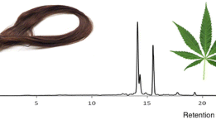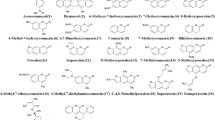Abstract
Currently, illegal addition of anti-infective drugs has been detected in some cosmetics to achieve rapid sterilization and anti-inflammatory effects. However, the abuse of anti-infective drugs may endanger the health of citizens. Thus, methods for the detection and quantitative determinations of such substances should be developed. In this paper, a method combining ultra-high-performance liquid chromatography with quadrupole time-of-flight mass spectrometry (UHPLC-Q-TOF HRMS) was designed. Its significance and potential were verified by the identification, confirmation, and quantification of 37 illegally added anti-infective drugs in cosmetics that claimed to have anti-acne effects. The method validation revealed a satisfactory linear relationship, and each coefficient of determination (r2) was higher than 0.9943. The LOD and LLOQ results were in the ranges of 0.0003–0.1063 μg g−1 and 0.0012–0.3545 μg g−1, respectively. The accuracy ranged from 70.8 to 122.8%, whereas the intra- and inter-day precisions were in the ranges of 0.2–12.8% and 0.2–13.8%, correspondingly. The mean recoveries were in the range of 70.1–117.7%, and the matrix effects ranged from 73.0 to 121.4%. Of the 200 batches of cosmetics that claimed to have anti-acne effects, three batches were positive, with chemical components such as metronidazole, lincomycin, clindamycin, tinidazole and miconazole nitrate being discovered. Therefore, the Q-TOF spectrometry could be widely applied in routine screening of adulteration in cosmetics.






Similar content being viewed by others
References
Say YH, Wong YR (2021) Modifiable and non-modifiable epidemiological risk factors for acne, acne severity and acne scarring among Malaysian Chinese: a cross-sectional study. BMC Public Health 21:601
Xu HX, Li HY (2019) Acne, the skin microbiome, and antibiotic treatment. Am J Clin Dermatol 20:335–344
Fox L, Csongradi C, Aucamp M, Plessis JD, Gerber M (2016) Treatment modalities for acne. Molecules 21:1063
Jin W, Yang YJ, Wang WY, Ye JN (2009) Simultaneous determination of antibiotics in anti-acne cosmetics by rapid LC with DAD. Chromatographia 69:1221–1226
Wen YW, Li Y, Sun SZ (2019) Simultaneous determination of 17 quinolones in cosmetics by liquid chromatography tandem mass spectrometry. Contemp Med Symp 17:220–222
Liu T, Liu F, Chen L (2020) Evaluation of anti-inflammatory and anti acne efficacy of a Chinese herbal compound cosmetics. China Surfactant Deterg Cosmet 50:553–559
Hao G (2018) Determination of seven antibiotics in acne removing cosmetics by UPLC-MS/MS. Deterg Cosmet 41:26–29
Liu Y, Zhang F, Chang Y, Xue J, Yao SC, Hu CQ (2017) Determination of 17 adulteration of drugs in anti-acne cosmetics by liquid chromatography-tandem mass spectrometry with instant library searching. Chin J Pharm Anal 37:1693–1700
Cunha BA (2001) Antibiotic side effects. Med Clin N Am 85:149–185
Regulation (EC) No.1223/2009 of the European Parliament and of the Council of 30 November 2009 on Cosmetic Products, 2009
China Food and Drug Administration (2015) Safety and Technical Standards for Cosmetics, Beijing, China
Sarker Y, Hasan M, Paul T (2018) Screening of antibiotic residues in chicken meat in Bangladesh by thin layer chromatography. J Adv Vet Anim Res 5:140–145
Chen H, Lin Z, Tan C (2020) Application of near-infrared spectroscopy and class-modeling to antibiotic authentication. Anal Biochem 590:113514
Li XZ, Wang XN, Wang LY, Yang TY, Wang DL (2021) Duplex detection of antibiotics in milk powder using lateral-flow assay based on surface-enhanced raman spectroscopy. Food Anal Method 14:165–171
Yan QR, Wu WK (2017) Application of ultra performance liquid chromatography in the analysis of prohibited substance, restricted substances and functional ingredients in cosmetics. Chin Pharma Aff 31:74–78
Chiavarino B, Crestoni ME, Marzio AD, Fornarini S (1998) Determination of sulfonamide antibiotics by gas chromatography coupled with atomic emission detection. J Chromatogr B 706:269–277
Wang X, Chen R (2018) Simultaneous detection of 41 forbidden anti-infective drugs in cream cosmetics by LC-MS /MS. China Pharm 21:1388–1392
Lin L, Zhang Y, Tu XK, Xie LQ, Yue ZF (2015) Determination of 25 quinolones in cosmetics by liquid chromatography-tandem mass spectrometry. Chin J Chromatogr 33:275–281
Meng XS, Bai H, Guo T, Niu ZY, Ma Q (2017) Broad screening of illicit ingredients in cosmetics using ultra-high-performance liquid chromatography-hybrid quadrupole-Orbitrap mass spectrometry with customized accurate-mass database and mass spectral library. J Chromatogr A 1528:61–74
Kim NS, Yoo GJ (2017) Determination of 43 prohibited glucocorticoids in cosmetic products using a simultaneous LC-MS/MS method. Anal Methods 9:2104–2115
Ma Q, Xi HW, Ma HJ, Meng XS (2015) Simultaneous separation and determination of 22 coumarin derivatives in cosmetics by UPLC-MS/MS. Chromatographia 78:241–249
Gao JM, Ma CY, Duan Q, Gao WH, Li H (2021) Simultaneous determination of 16 illegally added drugs in capsule dietary supplements using a QuEChERS method and HPLC–MS/MS. Chromatographia 84:1009–1023
Liu FY, Zhang XF, Li YQ, Gao H, Ling PX (2018) Simultaneous screening and determination of eight tetracycline antibiotics illegally adulterated in herbal preparations using HPLC–DAD combined with LC–MS–MS. Chromatographia 81:303–314
Shi S, Wu YY, Zhou MH, Cheng QY (2020) Simultaneous analysis of 31 anti-impotence compounds potentially illegally added to herbal-based dietary supplements by ultra-high-performance liquid chromatography coupled with quadrupole time-of-flight mass spectrometry. J Chromatogr B 1144:122077
Lehner SM, Neumann NKN, Sulyok M (2011) Evaluation of LC-high-resolution FT-Orbitrap MS for the quantification of selected mycotoxins and the simultaneous screening of fungal metabolites in food. Food Addit Contam, Part A 28:1457–1468
Zhao M, Xu J, Qian DW (2014) Characterization of the metabolism of 5-hydroxymethylfurfural by human intestinal microflora using ultra-high performance liquid chromatography-quadrupole time-of-flight mass spectrometry. Anal Methods 11:3826–3833
Niu ZY, Luo X, Wang FM, Zhang L (2016) Fast screening and confirmation of 89 prohibited compounds in cosmetics using UPLC-LTQ/Orbitrap MS. J Chin Mass Spectrom Soc 37:201–212
Wang XB, Zheng J, Li JJ, Yu HY, Li QY, Xu LH, Liu MJ, Xian RQ, Sun YE, Liu BJ (2018) Simultaneous analysis of 23 illegal adulterated aphrodisiac chemical ingredients in health foods and Chinese traditional patent medicines by ultrahigh performance liquid chromatography coupled with quadrupole time-of-flight mass spectrometry. J Food Drug Anal 26:1138–1153
Wejnerowska G, Narloch I (2021) Determination of benzophenones in water and cosmetics samples: a comparison of solid-phase extraction and microextraction by packed sorbent methods. Molecules 26:6896
Xun ZQ, Liu DH, Huang RR, He S, Hu D (2017) Simultaneous determination of eight alkaloids and oleandrin in herbal cosmetics by dispersive solid-phase extraction coupled with ultra high performance liquid chromatography and tandem mass spectrometry. J Sep Sci 40:966–1973
Luo HT, Huang XL, Wu HQ, Zhang QY (2017) Simultaneous rapid determination of 81 glucocorticoids in cosmetics by dispersive solid phase extraction and liquid chromatography-tandem mass spectrometry. Chin J Chromatogr 35:816–825
Wittenberg JB, Zhou WL, Wang PG, Krynitsky AJ (2014) Determination of prostaglandin analogs in cosmetic products by high performance liquid chromatography with tandem mass spectrometry. J Chromatogr A 1359:140–146
Abedi G, Talebpour Z (2017) Modified QuEChERS as a novel sample preparation method for analysis of N-nitrosodiethanolamine in shampoo by high performance liquid chromatography. Anal Methods 35:1–10
Liu LP, Wang ZM, Zhao SH, Duan JH, Wang WJ, Liu SH (2018) Determination of total phthalate in cosmetics using a simple three-phase sample preparation method. Anal Bioanal Chem 410:1323–1331
Yang WH (2019) Determination of 8 diuretics in feed by HPLC-MS/MS. Cereal Feed Ind 4:57–61
USFDA (2018) Draft Guidance for Industry: Bioanalytical Method Validation. US Department of Health and Human Services, US, FDA, Center for Drug Evaluation and Research, Silver Spring, MD, USA
Acknowledgements
The authors wish to extend appreciation to Agilent Technology for technical support.
Funding
This project was supported by Science and Technology Project of Zhejiang Medical Products Administration——Study on quality standard of plant raw materials used in cosmetics—bletilla striata extract and camellia oil (2021036).
Author information
Authors and Affiliations
Corresponding author
Ethics declarations
Conflict of Interest
The authors declare that they have no conflicts of interest.
Additional information
Publisher's Note
Springer Nature remains neutral with regard to jurisdictional claims in published maps and institutional affiliations.
Supplementary Information
Below is the link to the electronic supplementary material.
Rights and permissions
Springer Nature or its licensor holds exclusive rights to this article under a publishing agreement with the author(s) or other rightsholder(s); author self-archiving of the accepted manuscript version of this article is solely governed by the terms of such publishing agreement and applicable law.
About this article
Cite this article
Gao, Y., Chen, C., Wang, R. et al. Simultaneous Determination of 37 Anti-infective Drugs Potentially Illegally Added to Cosmetics that Claimed to have Anti-acne Effects by UHPLC-Q-TOF HRMS. Chromatographia 85, 1017–1028 (2022). https://doi.org/10.1007/s10337-022-04206-3
Received:
Revised:
Accepted:
Published:
Issue Date:
DOI: https://doi.org/10.1007/s10337-022-04206-3




